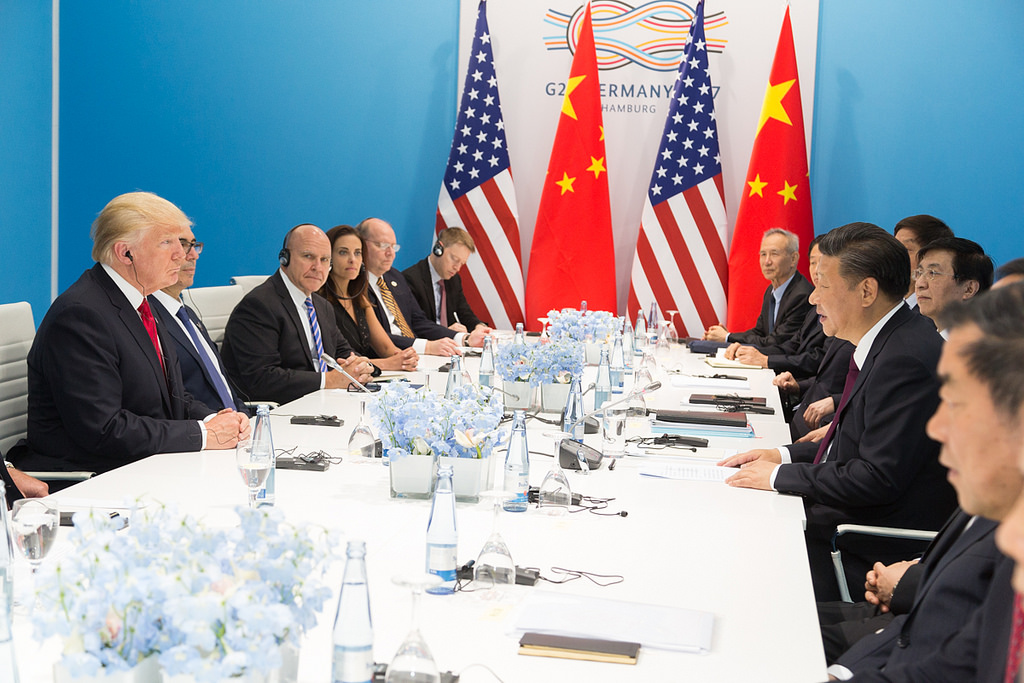In the Balance: The Future of America’s National Security and Innovation Ecosystem
As the G20 summit in Buenos Aires gets underway, speculation continues to mount over whether U.S. President Donald Trump and Chinese President Xi Jinping can achieve a breakthrough that would put a floor under U.S.-China trade tensions and the ever-deteriorating bilateral relationship.

Published by The Lawfare Institute
in Cooperation With

As the G20 summit in Buenos Aires gets underway, speculation continues to mount over whether U.S. President Donald Trump and Chinese President Xi Jinping can achieve a breakthrough that would put a floor under U.S.-China trade tensions and the ever-deteriorating bilateral relationship. But a potentially more consequential discussion has already started in Washington that deserves more attention than it has received to date. This conversation, playing out in the ordinarily-mundane context of public comments on a Commerce Department advance notice of proposed rulemaking, carries significant implications not only for U.S.-China relations but for the broader future of U.S. national security and America’s economic competitiveness. The question boils down to whether the United States can figure out a way to protect strategically sensitive emerging technologies without undermining the economic ecosystem that gives rise to those technologies. It’s an innovation-security conundrum that implicates the very foundations of American economic and military power—and it’s not at all clear how this is going to turn out.
Here’s the backstory: Congress and the Trump Administration have long worried about China’s unfair practices related to acquisition of U.S. technology—from cyber-theft of intellectual property to state-subsidized investments in U.S. companies to domestic joint venture requirements and other regulatory barriers that condition U.S. firms’ access to the Chinese market on forced transfer of technology to Chinese entities. Whatever views some U.S. officials may hold about the bilateral trade deficit, longstanding U.S. concerns over technology transfer and the future of the American tech sector are at the core of ongoing trade and investment tensions.
Part of the concern is that Chinese policies and practices distort markets and undermine the ability of U.S. firms to compete fairly in key technology sectors that are poised to be the main drivers of economic growth into the future—semiconductors, artificial intelligence, robotics, quantum computing and the like. Another aspect of the concern is that many of these technologies are inherently “dual-use,” having both civilian and military applications (e.g., the same image recognition technology used in social networking can also be used for surveillance and targeting). They can also supply the data-rich foundations for future technologies that may be both militarily sensitive and commercially valuable.
Nor is there a clear dividing line between these concerns: If America loses its competitive edge in developing and commercializing the technologies of the future, this erosion of U.S. economic power will also diminish the innovation base needed for technological military and intelligence advantage over potential adversaries.
These issues animated two important new statutes enacted in August as part of the omnibus Fiscal 2019 National Defense Authorization Act: the Foreign Investment Risk Review Modernization Act (FIRRMA) and the Export Control Reform Act (ECRA). FIRRMA expands the authority of the Committee on Foreign Investment in the United States (CFIUS) to review a broader range of foreign investments for national security risks, particularly non-controlling investments in U.S. “critical technologies.” Complementing this new authority, ECRA authorizes the Secretary of Commerce to lead a “regular and ongoing” interagency process to identify “emerging and foundational” technologies that are “essential to the national security of the United States” and thus should be subject to export controls that target a small group of countries including China. (These emerging and foundational technologies are also, by definition, considered “critical technologies” for purposes of CFIUS review.) In October, the Treasury Department rolled out a pilot program to implement the new “critical technologies” authorities under FIRRMA. Now the Commerce Department’s Bureau of Industry and Security (BIS) is set to implement the “emerging technologies” provisions of the updated export control regime and is seeking public comments until Dec. 19 on how to construct that regime (the identification of “foundational” technologies will be initiated in a future rulemaking notice).
As I have written about previously, ongoing advances in artificial intelligence and next-generation technologies create enormous definitional challenges in determining whether an emerging or foundational technology is essential to U.S. national security. It’s far from a simple matter of adding “killer robots” to the export control list. This is in part because, as explained in an influential DIUx report by Michael Brown and Pavneet Singh,
these technologies—from artificial intelligence to robotics and virtual reality—will be foundational so that many applications or end-use technologies will be built upon them. These foundational technologies will be component technologies for future innovations much the same way that semiconductors have been components in all electronics, telecommunications and computing in the past several decades. This is especially true in the field of artificial intelligence, where the U.S. government is actively making investments to create the third wave of AI technology to achieve a future where machines can explain themselves to humans; where machines can create causal models, not just correlations; and where machines can take what they learn in one domain and apply the learnings to a completely different domain.
Does this mean that virtually every early-stage technology is essential to national security? A quick glance at the 14 “representative technology categories” in the Nov. 19 BIS rulemaking notice might lead one to conclude as much. The categories include AI and machine learning, biotechnology, microprocessors, data-analytics technology, quantum-computing technology, robotics and advanced materials. But the Commerce Department is not suggesting that export controls will be placed on all technologies within these categories. It is asking for stakeholders to help the agency determine whether, within these categories, there are “specific emerging technologies that are important to the national security of the United States for which effective controls can be implemented that avoid negatively impacting U.S. leadership in the science, technology, engineering, and manufacturing sectors” (emphasis mine).
There’s the rub: The U.S. government cannot summarily assert that AI is inherently dual-use and place all AI technology under export controls; doing so could undermine the very ecosystem of capital, data, and know-how that fuels AI innovation. As Greg Allen and Taniel Chan have noted, when the U.S. government set out to regulate the aerospace industry after World War II, the government was by far the largest customer for aircraft and funded most aerospace research and development. The same cannot be said for AI, “both because the government is not nearly as large a customer for AI companies and because most of the leading researchers in the field do not work for government.” Companies developing AI need viable commercial markets and large data sets. A sweeping restriction on AI “exports” could cause firms large and small to reduce or redirect their AI research and development when confronted with the costs of a cumbersome licensing and compliance process to sell their products in the massive and growing Chinese market. As MIT’s R. David Edelman has warned, doing so “would almost certainly give Chinese companies that don’t face those same restrictions a sizable advantage in the playing field.” Quite the opposite of the intended effect.
This is why ECRA instructs that the interagency process to identify emerging and foundational technologies must take into account the effect that technology export controls would have on the development of such technologies in the United States, as well as whether imposing controls on the transfer of an emerging technology will actually be effective in limiting foreign access to that technology. These tradeoffs must be seriously evaluated well beyond the Commerce Department’s current 30-day notice-and-comment period. They should be the subject of a broad public debate that engages experts who understand the risks of these emerging technologies as well as the risks of walling them off. Placing export controls on technologies that provide the U.S. a “qualitative military or intelligence advantage” is important, but such controls must be carefully tailored and commensurate with the risk of undercutting the ecosystems of data and capital (both financial and human) that enable those technologies and their successors to be developed.
The process outlined above must also engage like-minded allies and partners whose participation in multilateral export control regimes is crucial to their success—though President Trump has shown little recognition of the value of such allied cooperation to date. And importantly, the export control debate should not divert attention from other critical issues in protecting emerging and foundational technologies. This includes an urgent cybersecurity imperative: the need for companies and government agencies to secure AI-based systems against cyber exploitations that can give hackers access to the algorithms and underlying technologies employed by those systems.
Creating functional criteria for identifying and controlling the transfer of certain sensitive emerging technologies will be painstaking—much more so than the brief 30-day period for public comments on the Commerce Department’s new export control notice would suggest. But it is a crucial effort that should not be overshadowed by the Trump-Xi G20 encounter and its aftermath, regardless of whether a deal to halt the tit-for-tat escalation of tariffs emerges from the two leaders’ dinner meeting in Argentina. Indeed, this long-term project may well turn out to be one of the defining national security challenges of our time.





